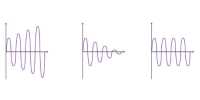Important terms used in wave motion
(i) Wavelength (λ): The distance travelled by a wave during which a particle of the medium completes one vibration is called wavelength. It is also defined as the distance between any two nearest particles on the wave having the same phase.
WThe wavelengths may also be defined as the distance between two successive crests or troughs in transverse waves, or the distance between two successive compressions or rarefactions in longitudinal waves.
(ii) Time period (T): The time period of a wave is the time taken by the wave to travel a distance equal to its wavelength.
(iii) Frequency (n): This is defined as the number of waves produced in one second. If T represents the time required by a particle to complete one vibration, then it makes 1/T waves in one second.
Therefore frequency is the reciprocal of the time period, n = 1/T.













